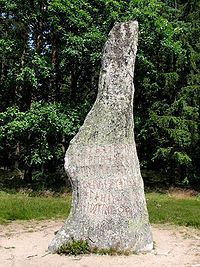Rundata ID DR 360 City/Village Björketorp Runemaster Unknown | Produced 500-700AD | |
 | ||
The Björketorp Runestone (DR 360 U) in Blekinge, Sweden, is part of a grave field which includes menhirs, both solitary and forming stone circles.
Contents
It is one of the world's tallest runestones measuring 4.2 metres in height, and it forms an imposing sight together with two high uninscribed menhirs.
Inscription
The runes were made in the 6th or the 7th century and in Proto-Norse (a similar message is given on the Stentoften Runestone). It is found on two sides. The shorter message appears to say "I foresee perdition" or "prediction of perdition". The message of the other side is also debated.
Transcription:
Translation:
Swedish: ”Mäktiga runors hemlighet dolde jag här, kraftfulla runor. Den som bryter detta minnesmärke skall ständigt plågas av arghet. Svekfull död ska träffa honom. Jag spår fördärv”.
Analysis
Most scholars date the inscription to the 7th century and it is carved with a type of runes that form an intermediate version between the Elder Futhark and the Younger Futhark. A characteristic example of this is the a-rune which has the same form as the h-rune of the younger futhark. This is the rune that is transliterated with A. The k-rune, which looks like a Y is a transition form between and in the two futharks. There are quite a few intermediary inscriptions like this one. Three more are known from Blekinge, i.e. the Stentoften Runestone, the Istaby Runestone and the Gummarp Runestone, which was moved to Copenhagen and lost in the Copenhagen Fire of 1728.
The Stentoften, Istaby and Gummarp inscriptions can be identified with the same clan through the names that are mentioned on them, and the names are typical for chieftains. The Björketorp Runestone lacks names and is raised some tens of km from the others. However, it is beyond doubt that the Björketorp runestone is connected to them, because in addition to the special runic forms, the same message is given on the Stentoften Runestone.
It is obvious that the runestones are not carved by the same man, and so it appears that the runestone reflects a specific tradition in Blekinge during the 7th century. Compared to the Stentoften inscription, the one on the Björketorp stone has a fuller, more formal and less archaic style.
Scholars are not in agreement on the purpose of the runestone. It has been suggested that the runestone is a grave and that the curse is intended to protect it. However, in 1914, there were archaeological excavations which did not present any finds either by the runestone or in the stone circle. To counter this, it has been suggested that the runestone is a Cenotaph, i.e. a memorial far from the real burial. A second suggestion is that it was a shrine for Odin or for fertility. A third suggestion is that the runestone marks a border between the Swedes and the Daner.
